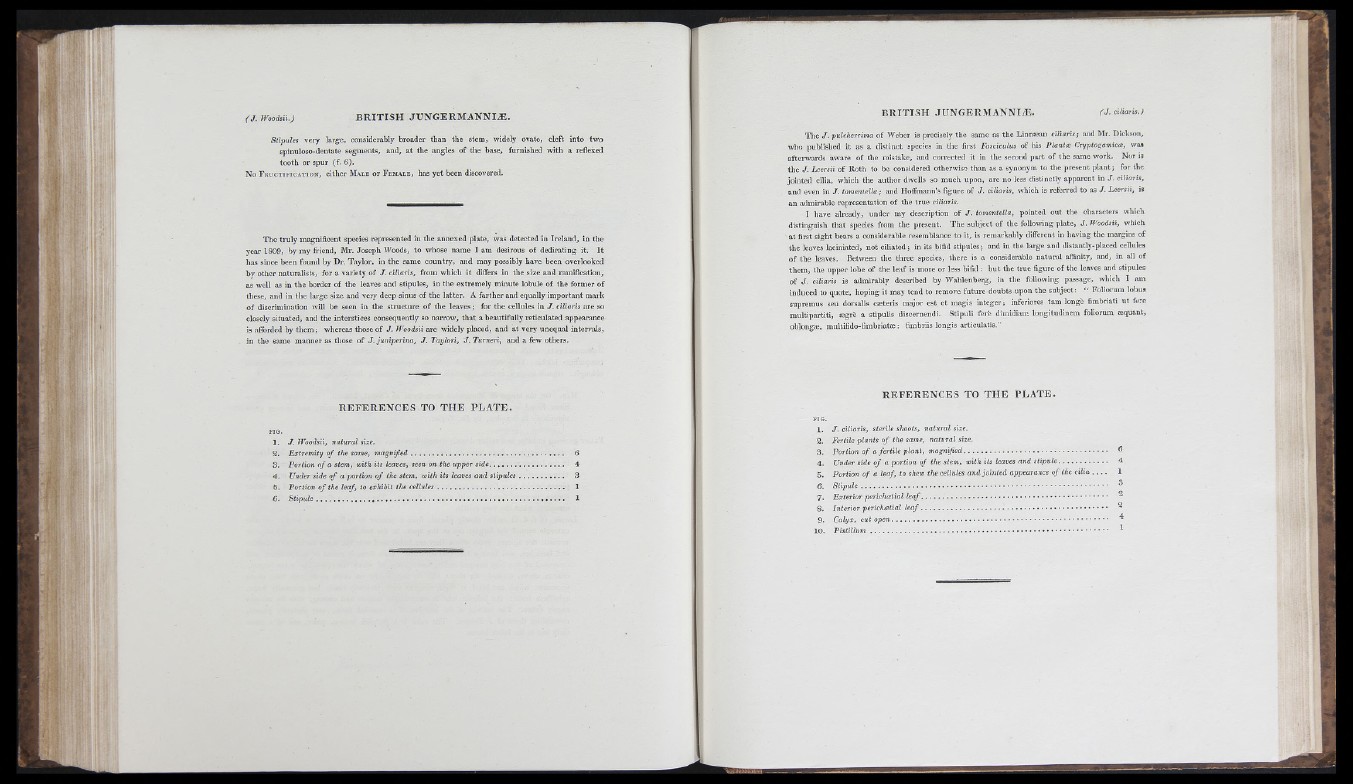
Stipules very la rg e , considerably broader than th e stem, widely ovate, cleft in to two
spinuloso-dentate segments, and, a t th e angles o f th e b ase, furnished w ith a reflexed
to o th o r spur (f. 6).
No F b u c t if ic a t io n , eith e r RIa l e o r F em a l e , has ye t been discovered.
Th e tru ly magnificent species represented in the annexed p late, was detected in Ire lan d , in the
year 1S09, by my friend, Mr. Joseph Woods, to whose name I am desirous of dedicating it. I t
has since been found by Dr. Taylor, in th e same co untry, and may possibly have been overlooked
by other naturalists, for a variety of J . ciliaris, from which it differs in the size and ramification,
as well as in th e border o f the leaves and stipules, in th e extremely minute lobule o f th e former of
these, and in th e la rge size and very deep sinus o f th e la tte r. A fa rth e r and equally im p o rtan t m a rk
o f discrimination will be seen in th e stn ic tu re o f the leaves ; for th e cellules in J . ciliaris a re so
closely situated, and the interstices consequently so narrow, th a t a b eautifully reticulated appearance
is afforded by them j whereas those o f J . Woodsii are widely placed, and a t very unequa l intervals,
in the same manne r as those o f J . junipe rina, J . Taylori, J . Turneri, and a few others.
R E F E R E N C E S T O T H E P L A T E .
f ig .
1. J . Woodsii, natural size.
2. E xtremity o f the same, m a g nified..................................................................................... 6
3. Portion o f a stem, with its leaves, seen on the upper side.......................................... 4
4. Under side o f a portion o f the stem, with its leaves and s tip u le s.......................... 3
5. Portion o f the leaf, to exhibit the c e llu le s....................................................................... 1
6. S t ip u le ............................................................................................................................................ 1
The J- pulcherrima o f Weber is precisely th e same as th e Linnæan ciliaris; and Mr. Dickson,
who published it as a d istinc t species in th e first Fasciculus o f his Plantæ Cryptogamicæ, was
a fte rwa rds aware of the mistake, and corrected it in th e second p a rt o f the same work. Nor is
th e J . Leersii o f Ro th to be considered otherwise th a n as a synonym to the present p la n t; for the
jointed cilia, which th e author dwells so much upon, are no less distinctly appa rent in J . ciliaris,
and even in J . tomentella ; and Hoffmann's figure of J . ciliaris, which is referred to as J . Leersii, is
a n admirable representation o f th e tru e ciliaris.
I have already, u n d e r my description o f J . tomentella, pointed out th e characters which
distinguish th a t species from the present. T h e subje c t o f th e following p late, J . Woodsii, which
a t first sig h t bears a considerable resemblance to it, is remarkably different in having the margins of
th e leaves laciniated, n ot cilia ted; in its bifid stipules; and in the la rge and distantly-placed cellules
o f the leaves. Between the th re e species, there is a considerable n a tu ra l affinity, and, in all of
th em , the uppe r lobe o f th e le a f is more or less bifid : b u t the true figure o f the leaves and stipules
o f J . ciliaris is admirably described by Wahlenberg, in th e following passage, which I am
induced to quote, hoping it may tend to remove fu tu re doubts upon the subject: “ Foliorum lobus
supremus seu dorsalis cæteris major est e t magis in teg e r; inferiores tam longb fimbriati u t fere
m u ltip a rtiti, ægrè a stipulis discernendi. Stipuli ferè dimidiam longitudinem foliorum æquant,
oblongæ, multifido-fimbriatæ : fimbriis longis a rticulatis.”
R E F E R E N C E S T O T H E P L A T E .
J . ciliaris, sterile shoots, natural size.
Fertile plants o f the same, natural size.
Portion o f a fe r tile p la n t, magnified................................................................................... ®
Under side o f a portion o f the stem, with Us leaves and s tip u le ............................... 4
Portion o f a leaf, to shew the cellules and jo in ted appearance o f the cilia . . . . 1
S t ip u le ........................................................................................................................................... ^
Exterior perichælial le a f......................................................................................................... 2
Interior perichætial l e a f ....................................................................................................... 2
Calyx, cut op en ............................................................................................................................. ^
P i s t il lu m ...................................................................................................................................... ^